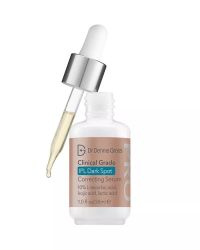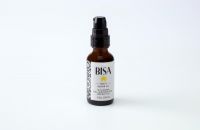 DERMASCOPE
The authority on professional skin care
DERMASCOPE
The authority on professional skin care
Restoring Collagen: Holistic Firming and Tightening Strategies for the Face
Written by Elina FedotovaWhen analyzing a client's skin on a facial table, they may appear to have a practically perfect complexion with a smooth texture and minimal discolorations. But, as soon as the client stands up, their appearance can change drastically due to the effects of gravity. No matter how many facials, acid peels, and skin polishing microdermabrasion treatments are performed, it will not significantly change a sagging complexion. Because the face has lost a significant amount of volume and does not have sufficient muscle tone to support dermal tissue, skin care professionals need to look deeper and focus on collagen restoration and stimulating facial muscles.
The loss of facial collagen and elastin is a leading factor when it comes to the decline of tone and firmness in the face. This process can start before the age of 30 and depends on an individual’s genetic predisposition, levels of oxidative and emotional stress, as well as inflammation, glycation, and hormonal imbalances. Collagen and elastin are the principal structural proteins found in the body’s molecular scaffolding. They give structural support to the skin and entire face.
SKIN LIFTING AND FIRMING PROCEDURES
At a medical spa, in addition to surgical face lifts, clients are usually offered injectable fillers to help make their face look fuller and immediately reduce deep lines and wrinkles. But, fillers by themselves cannot reduce the effects of gravity. Clients who are not ready for invasive treatments can choose to receive a fibroblast radio frequency treatment. The heat generated by this procedure creates a controlled, superficial dermal injury, in order to initiate the inflammatory response. This process stimulates the renewal of tissues in the dermal layers. Radio frequency is a widely accepted technology that has been around for a long time. Swelling or redness may appear in the treated areas and sensations of a mild sunburn (redness, peeling, and swelling) may also last a few days after treatment.
At a holistic, clinical spa or the offices of physicians who practice regenerative medicine, clients can receive injectable fillers made from their own fat or plasma, instead of synthetic fillers. One of the most popular skin firming treatments is platelet-rich plasma therapy.
Platelet-Rich Plasma Therapy
Platelet-rich plasma therapy is used to rejuvenate the skin and provide a younger look through the repair of tissue, collagen, and elastin formation. Numbing cream is applied over the face. Blood is then taken from the patient’s vein and spun in a centrifuge to isolate platelet-rich plasma. Then, platelet-rich plasma is microneedled into the face. It can also be injected with a syringe. Growth factors found in the platelets activate stem cells, which are already present in the skin. This leads to the development of new collagen, which, in turn, repairs and rejuvenates the skin. For maximum results, a total of three treatments, one to two months apart, is recommended. There is practically no down time, but clients may feel some swelling, redness, and dryness for two to three days.
Microneedling
Microneedling, also known as collagen induction therapy, is a process involving repetitive puncturing of the skin with sterilized microneedles to create a controlled skin injury. This also helps to restore the skin and penetrate collagen by rebuilding nutrients more deeply into the dermis. The most common side effect is minor skin irritation immediately following the procedure which can last three to four days.
Natural Injectable Fillers
Fillers made from a client’s own plasma can be used as an alternative to synthetic or artifical fillers. It is not a very popular procedure because it is faster and easier to inject pre-made, artificial fillers. But, for those looking for 100% natural injectable skin firming solutions, the use of fillers made from their own blood is a great choice. The plasma, which is extracted from the client’s own blood, can be turned into a gel-like consistency by a physician and then injected into the hollow areas of the face. Fillers made from a client’s own plasma not only help to add volume and fill in lines like their artifical twins, but also assist in the formation of new collagen and elastin.
Just like regular platelet-rich plasma, this treatment involves taking some of the client’s blood and separating out the plasma by centrifuge. The plasma can then be processed, through simple heating and cooling, to produce a desirable consistency. Then, natural fillers, solely made from the client’s blood, are injected into the face to immediately create a smoother look. Typically, natural gel fillers will last approximately three to six months, just like conventional fillers. However, when combined with platelet-rich plasma, the growth factors in platelet-rich plasma help prolong the life of the natural gel filler. Platelets contain growth factors, which are very important in the repair and regeneration of collagen.
Non-Surgical Thread Face Lift
This minimally invasive injectable procedure helps to create structural support for the entire face, while simultaneously stimulating the regeneration of dermal tissue. During this non-surgical treatment, the physician injects tiny sutures or threads into the skin. These multi-strand threads serve as a type of scaffolding for new bundles of collagen that the body starts to produce. They surround each thread to create a subtle yet lifting effect. The results of a thread face lift can be enhanced by using additional platelet-rich plasma injections. There is no scarring and minimal, if any, bruising. Recovery time takes up to three weeks.
Results vary but can last up to three years. If the client needs more volume added to their face, fat transfers can be used in combination with the thread face lift.
Face Fillers Made with the Client’s Body Fat
This procedure is often called a fat transfer. This advanced non-surgical, rejuvenating treatment is used to address loss of volume in the face. Fat, harvested from the client’s body, with a syringe or miniature lyposuction, is usually mixed with platelet-rich plasma and injected into various areas of the face for additional stimulation of collagen and elastin.
Procedures like platelet-rich plasma, fat transfers, and thread face lifts are injectable alternatives to surgical procedures. They should provide immediate results lasting up to two to three years. Regenerative approaches to aesthetics, which primarily use soft tissue regeneration processes, are less invasive procedures that result in a much more natural look. The client will not have to worry about scar tissue or long down time. Moreover, minimally or non-invasive therapies usually provide a much more pleasant experience for the client.
SKIN TIGHTENING BOTANICALS AND MINERALS
This next part of the article will focus on methods and ingredients that aestheticians can use in their treatment room to help clients achieve firmer skin after each visit.
But, to achieve visible results, the skin care professional first needs a commitment from the client to make sure a suggested facial home regimen of collagen regenerating skin care products is used – products that can deeply penetrate protein-restoring nutrients into the live cells of the skin. Skin care professionals also need to discuss lifestyle with the client, as well. To support skin restoring processes from inside out, clients must follow a diet that includes:
- a significant amount of antioxidants from bright colored fruits and vegetables
- omega-3 and -6 fatty acids from fish, nuts, and flaxseeds
- vitamin C from citrus and rose hips
- vitamin B from mushrooms and rye bread
Many botanicals and minerals can deliver collagen-restoring vital nutrients in a bioavailable form recognizable by the body. Here are some natural ingredients that offer visible firming and tightening results.
Hibiscus
Extract of organic hibiscus contains good amounts of vitamin C and other antioxidants, such as flavonoids. Vitamin C is essential for collagen production and involved in the regeneration and maintenance of connective and muscle tissues. Hibiscus has also been shown to increase the circulation, which can also improve elasticity and tighten the skin.
Rosemary
Extract of organic rosemary has excellent skin detoxifying and toning properties. It improves a sagging complexion by increasing blood circulation. It also aids in the delivery of additional nourishing nutrients to skin cells.
Ginkgo Biloba
Organic ginkgo biloba contains 49 different antioxidants that have the ability to counter free radicals and protect cellular DNA. Ginko biloba also improves blood flow, which in turn speeds delivery of nutrients and oxygen into skin cells to boost firmness and improve skin tone.
Jasmine
Jasmine is known as the king of oils. It has a pleasant, sensual scent and complex carbohydrates, which help to firm the skin and assist in dermal moisture retention.
Mushrooms
Mushrooms like chaga, reishi, maitake, and shiitake contain powerful blends of polyphenols and antioxidants. Reishi and chaga have been used for centuries for health and beauty around the world. The reishi mushroom has been called the mushroom of immortality. It contains ganoderic acid, an antioxidant, anti-inflammatory, skin renewing, and wrinkle reducing triterpene.
Morels, oysters, truffles, and shiitake mushrooms also contain super high concentrations of antioxidants, vitamins and minerals, like vitamins B2, B3, and D, as well as calcium and phosphorus. Some of these nutrients also work as immune modulators and help to firm the skin by stimulating natural self-repair mechanisms.
For example, vitamin B3, also known as niacinamide, can do it all. “It has anti-inflammatory properties, prevents abnormal pigment production, improves hydration, and promotes healthy collagen and elastin regeneration,” says Dr. Zeichner MD, director of cosmetic and clinical research at the Mount Sinai Hospital in New York City, New York.
Snow mushroom, golden jelly fungus, or yellow trembler (tremella) produce results comparable to hylauronic acid. One study revealed that a particular skin care formulation with 0.05% tremella polysaccharides was able to retain more moisture than one that used 0.02% hyaluronic acid instead. Tremella also delays skin aging by reducing the peroxidation of cell lipids – when free radicals steal electrons from lipids within cell membranes, which damages cells.
Copper
Bioavailable copper plays an important role in skin firming by enhancing collagen regeneration. It also helps tighten the skin, because it aids in supporting the bond between collagen and elastin.
Zinc
Helps to tighten the skin by supporting collagen production. It activates proteins essential for collagen synthesis like collagenase, which allows skin cells to remodel collagen.
Liposomes
Most skin firming formulations contain liposomes – spherical vesicles, whose membranes consist of a bilayer of special amphiphilic molecules. Liposomes have the ability to capture and deliver active antiaging ingredients through the protective layer of the epidermis right down to the cellular level. Encapsulation of vitamins in liposome form also increases the stability of the vitamins. Liposomes are often made from soy or sunflower phospholipids (microscopic plant fat particles). Today, many clients are concerned about the estrogenic effects of soy, so consider suggesting formulations with sunflower liposomes or liposomes that come from other sources.
Peptides
One of the most powerful ingredients available to firm the skin are natural peptides. What are peptides? They are short chains of no more than 50 amino acids that have the ability to trigger the regeneration proteins. Elastin is a highly elastic protein in connective tissue containing primarily amino acids, like glycine and valine and modified alanine and proline residues. Elastin helps skin to return to its original position after being stretched. Collagen is a protein made up of amino acids – glycine, proline, hydroxyproline, and arginine.
How do peptides work? Natural peptides, whether applied topically or taken internally, have the ability to find and restore proteins damaged by the aging process. They add antiaging, deeply hydrating, and skin-restoring properties to skin care formulas.
For best results, clients should use skin care products, together with dietary supplements, that contain natural peptides. Peptides that are extracted from natural sources come from the cytomax class. A good example are marine collagen peptides. These are low-molecular-weight peptides, enzymatically hydrolyzed from the collagen tissues of marine fish. Due to their antioxidant and antimicrobial properties, marine collagen peptides increase skin elasticity.
Silk peptides are obtained from silkworms. They can be used to calm irritated skin due to their anti-inflammatory properties. They effectively help the skin to retain its moisture and elasticity. Because of their high molecular weight, silk peptides coat the skin with natural silky film, which further protects skin from dehydration and gives it a smooth texture. “I prefer to use natural versus synthetic sources of peptides, because they are less likely to cause adverse reactions,” says professor Vladimir Khavinson, M.D., an innovator in the field of peptides and director of the Saint-Petersburg, Russia Institute of Bioregulation and Gerontology.
Amber
Amber is a warm, golden-colored natural form of fossilized resin. It is said that aristocratic Roman women would play with amber pieces, holding and stroking nuggets with their hands, as it was thought to impart a youthful look. Their intuition was correct. Amber contains 3% to 8% amber acid, also known as succinic acid. Amber acid is a powerful antioxidant. It helps to firm the skin by reducing toxins and free radicals that weaken the skin.
A study shows that a skin care product containing Baltic amber activates sirtuin-1, a key antiaging gene. The study used one of the latest genomic tools available to measure how skin cells react to proteins on a molecular scale. The findings on the amber-containing skin care product yielded the following results:
- It increased the expresssion of sirtuin-1, a key antiaging gene.
- It activated the expression of specific collagens, keratins, and matrix genes with anti-wrinkle effects.
- Exposure to it produced a statistically significant change in 47 out of 91 genes in 48 hours.
COMPLEMENTARY TECHNIQUES
When used in tandem with skin rejuvenating topicals like those mentioned above – botanicals, peptides, and certain minerals – phototherapy, microcurrent, and soft laser devices can effectively restore the integrity of aging skin.
Microcurrent
Energy emitted by microcurrent devices is a low-level current similar to the body’s current. It is a gentle therapy that most clients find very pleasant and delivers both real time and cumulative toning and firming effects on the skin.
It helps to restore muscles to their pre-gravity state. It also delivers skin firming and tightening formulations deeper into the skin to boost collagen and elastin production, as well as protein synthesis. While it is safe to use on the skin of the face, neck, and under-eye area, it should not be used on the eyelids.
Massage
Manual massage, acupressure, massage with rollers made from semi-precious stones, and gua sha can help to break up stagnant energy, improve blood circulation, and energize the skin. They are very helpful for tightening and toning the skin. Facial acupressure is known to improve blood and lymph circulation, help to stimulate face muscles, reduce wrinkles, and tighten the dermis.
Red Light Therapy
Cold laser and red LED devices help restore the integrity of the skin roughly five millimeters below the surface. This process is believed to boost performance of cellular mitochondria, the powerhouse of the cell, and allow them to act more efficiently, while generating the creation of collagen and fibroblasts to rebuild the skin. Red light therapy has been thoroughly researched and proven to be safe and effective by hundreds of studies all over the world.
COMPLETE FACE, NECK, AND DÉCOLLETAGE FIRMING TREATMENT
For this protocol, prepare an herbal decoction or facial tea made from plants that help to stimulate microcirculation like ginkgo biloba. Botanicals with high levels of antioxidants and anti-inflammatory nutrients, like rose petals, rose hips, rosemary, and calendula, can be used. In some cases, to improve aging complexions, use herbs that contain phyto-estrogens, like red clover. This herbal tea can be used in place of water to cleanse the face and also for herbal compresses.
- Steam and cleanse the skin with a sulfate-free, natural cleanser.
- Perform vacuuming and cupping treatments to purify the skin. This will intensify blood circulation in specific areas, like deep lines and wrinkles.
- Exfoliate and brighten the skin with the application of a natural 15% alpha hydroxy acid solution or concentrated extract of rose hips. Rose hips are the best natural source of vitamin C, as well as many other beauty nutrients, which are extremely important for collagen regeneration.
- Apply warm herbal compresses made from a blend of the special skin-restoring botanicals listed above.
- Perform gentle lymph drainage massage over the compresses for a few minutes and remove them.
- Apply a serum made from natural peptides over the face, neck, and décolletage.
- Microneedle the face, neck, and décolletage to stimulate skin restoring processes and penetrate the serum. For those aestheticians under a physician’s supervision, use an ultrasonic device to penetrate the serum instead of microneedling treatment. Remember, always check with your state board of cosmetology regarding microneedling and other skin care devices.
- Ozonate the skin with a high frequency device for two minutes to sanitize it, increase blood circulation, and intensify the skin rejuvenation processes.
- Apply a wild mushroom-based mask mixed with sunflower phospholipids and vitamin C.
- Perform red light therapy (LED or cold laser) or radio frequency to stimulate microcirculation and protein rebuilding processes, as well as penetrate the mask into the skin.
- Apply the herbal compresses over the face.
- Perform acupressure massage through the herbal compresses.
- Apply and gently massage an amber-based serum over the face, neck, and décolletage.
- Perform a microcurrent muscle-stimulating treatment.
- Mist the skin with a botanical-based toner.
- Complete the procedure with the application of organic, antiaging serums, and face, neck, and eye creams. Protect the skin from sun damage with a zinc oxide-based sunscreen.
Using a comprehensive approach to address collagen loss, professionals can effectively work with their clients to improve aging skin.
References
Higuera, Valencia. “Understanding Gua Sha: Benefits and Side Effects.” Healthline. https://www.healthline.com/health/gua-sha.
Oláh, Attila, Balázs I. Tóth, István Borbíró, Koji Sugawara, Attila G. Szöllõsi, Gabriella Czifra, Balázs Pál, Lídia Ambrus, Jennifer Kloepper, Emanuela Camera, et al. “Cannabidiol exerts sebostatic and anti-inflammatory effects on human sebocytes.” The Journal of Clinical Investigation 124, no. 9 (2014): 3713-3724.
https://www.ncbi.nlm.nih.gov/pmc/articles/PMC4151231/.
Pontius, Allison T. and Pamela W. Smith. “An Antiaging and Regenerative Medicine Approach to Optimal Skin Health.” Facial Plastic Surgery 27, no. 1 (2011): 029-034. https://www.thieme-connect.com/products/ejournals/abstract/10.1055/s-0030-1270416?device=mobile&innerWidth=980&offsetWidth=980.
“Prof. Vladimir Khavinson.” http://khavinson.info/publications.
“PRP Platelet-Rich-Plasma.” American Regenerative Clinic. https://americanregen.com/prp-platelet-rich-plasma/.
“The Truth About Microcurrent.” Truth in Aging. https://www.truthinaging.com/review/the-truth-about-microcurrent.
Young, David G. “Microcurrent.” All Natural Doctor. https://allnaturaldoctor.com/resources/topic.php?name=Microcurrent.
 Elina Fedotova is the formulator and CEO of Elina Organics and an award-winning cosmetic chemist and aesthetician. She hand makes her professional skin care line in her laboratory using holistic principles and organic ingredients from around the world. In 2007, she founded the Association of Holistic Skin Care Practitioners (AHSCP), a nonprofit organization that provides ongoing training and education for professionals. We know that beauty is more than skin deep and that a person is much more than a physical body. Our well-being requires mental clarity, positive emotions, whole food, and a clean environment. By taking a “whole-listic” approach to our health and personal care, we can continuously feel and look our best, care more about our resources, and help create a harmonious life for all.
Elina Fedotova is the formulator and CEO of Elina Organics and an award-winning cosmetic chemist and aesthetician. She hand makes her professional skin care line in her laboratory using holistic principles and organic ingredients from around the world. In 2007, she founded the Association of Holistic Skin Care Practitioners (AHSCP), a nonprofit organization that provides ongoing training and education for professionals. We know that beauty is more than skin deep and that a person is much more than a physical body. Our well-being requires mental clarity, positive emotions, whole food, and a clean environment. By taking a “whole-listic” approach to our health and personal care, we can continuously feel and look our best, care more about our resources, and help create a harmonious life for all.










